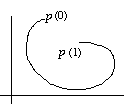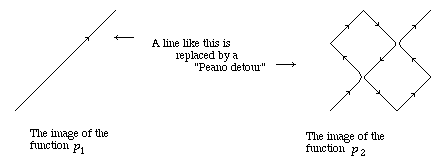
You can think of a path or a curve in R2 as the image of a continuous function p from the interval [0, 1] to R2.
| Previous page (The Golden Ratio) | Contents | Next page (More about the delta-function) |
We saw that there is a one-one correspondence between, say, the rationals in the interval [0, 1] and the set Q × Q. So it is not so unlikely that there are at least as many points in the interval [0, 1] as there are in the unit square [0, 1] × [0, 1].
In fact the map which takes a real number 0.a1a2a3... to the pair (0.a1a3a5... , 0.a2a4a6... ) is an onto map. (It is only the fact that reals with terminating decimals can either end in 000... or 999... that stops it from being a one-one correspondence.)

You can think of a path or a curve in R2 as the image of a continuous function p from the interval [0, 1] to R2.
Here is a picture:
However, this picture may be a bit misleading. In 1890, the Italian mathematician Giuseppe Peano (1858 to 1932) devised a continuous curve which goes through every point of the unit square. Of course, the picture of its image is not very interesting!

Here is how you can make it:
Then, to make p3, one replaces each of the straight line segments in p2 by a similar "Peano detour". And so on.

Here is what the image of p4 looks like when it is "partially drawn":
This will give a sequence (p1 , p2 , p3 , ... ) of continuous maps from [0, 1] to R2, which, with a bit of effort, one can show forms a Cauchy sequence under the metric d∞. Then the theorem about the completeness of spaces of functions under this metric shows that the sequence converges to a continuous map from the interval to the unit square.
To see that the path does go through every point of the square, observe that the "grid" that you get gets tighter and tighter as you take more and more paths in the sequence, and so any point in the plane will be the limit of points in the images of the pn's. Of course, the limit of the paths will have infinite length, but it will be continuous.
| Previous page (The Golden Ratio) | Contents | Next page (More about the delta-function) |